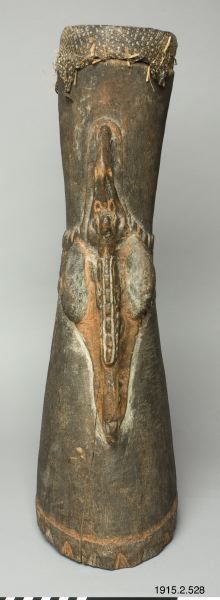Connect with Horniman Museum and Gardens
Contact this content partner to get more information about this item.
hourglass drum
- Description:
- Drum, Aopa, Purari River Delta, Gulf Province, Papua New Guinea The aopa drums of the Purari delta share some features with the other drums of New Guinea, and have some features that are distinctive. Many drums of southern New Guinea have a narrow ‘waist’ that gives them an hourglass shape, but most have two squared-off ends. Those of the Purari and other river deltas around the Papuan Gulf, have an open end opposite the drum skin that takes the form of two pointed jaws. The surface engraving is also distinctive of the Papuan Gulf cultures. For the peoples of the Purari delta, one of the great heroes of ancient times was a man by the name of Iko. According to legends, Iko came into the Purari delta from the west, bringing the knowledge of many good things with him. This included how to grow and consume coconuts, and the methods of making and playing aopa drums. Wood, reptile skin, split bamboo, pigment. Circa 1900. Collected by Dr Emile Clement and purchased by the Museum in 1928. Single membrane hourglass-shaped drum with a skin of monitor lizard bound on with a ring of cane. Wooden shell with a short cylindrical waist at the centre, expanding towards both ends. There is an integral handle at the waist. The open end of the drum is formed into a V shape mouth with two painted and pointed projections. The lower half of the drum is engraved with facial motifs surrounded by meandering curvilinear forms and zig zag infilling which is inlaid with white lime paint.
- Format:
- image
- Collections:
- Horniman Museum and Gardens
- Content partner:
- Horniman Museum and Gardens
- Availability:
- Not specified
-
Copyright status: All rights reservedFind out more about what you are able to do with this itemThis item is all rights reserved, with means you'll have to get permission from Horniman Museum and Gardens before using it. For more information, please see our use and reuse page.More informationHorniman Museum and Gardens has this to say about the rights status of this item:
http://rightsstatements.org/vocab/InC/1.0/
What can I do with this item?Non-infringing useNZ copyright law does not prevent every use of a copyright work, and this item may be hosted by an international institute or organisation. You should consider what you can and cannot do with a copyright work.No sharingYou may not copy and/or share this item with others without further permission. This includes posting it on your blog, using it in a presentation, or any other public use.No modifyingYou are not allowed to adapt or remix this item into any other works.No commercial useYou may not use this item commercially.
Welcome and warm Pasifik greetings
The information on this site has been gathered from our content partners.
The names, terms, and labels that we present on the site may contain images or voices of deceased persons and may also reflect the bias, norms, and perspective of the period of time in which they were created. We accept that these may not be appropriate today.
If you have any concerns or questions about an item, please contact us.

